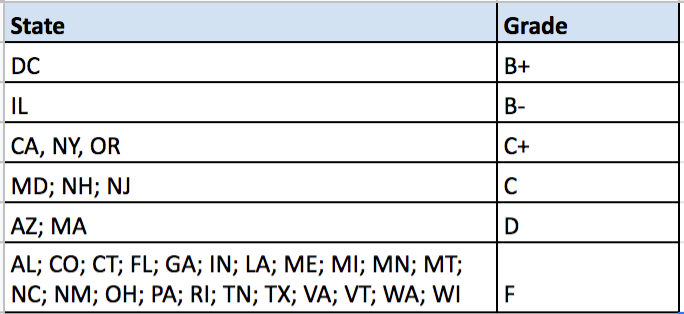New Report: More Than Two-Thirds Of States Examined Receive Failing Grades For Efforts To Reduce Lead In School Drinking Water
A total of 22 states earned an “F” grade for their performance in eliminating lead from school drinking water, according to a new study by Environment America Research & Policy Center and U.S. PIRG Education Fund. Of the 31 states tested, Illinois was the only one (along with the District of Columbia) to receive a mark above the C range. These results come from the the second edition of the groups’ Get the Lead Out report, which grades state policies for protecting kids from exposure to this dangerous neurotoxin.
“Our kids deserve safe drinking water where they go every day to learn and play,” said Faye Park, president of U.S. PIRG Education Fund. “In light of these low marks, we join with doctors, parents and local officials from across the country to call for swift action to ensure lead-free water at schools and daycare centers. We must get the lead out now.”
As the research shows, lead in drinking water remains a pervasive threat at schools across the country. For example, more than half the schools tested in Massachusetts, Texas and Washington, had lead in the drinking water.
“As more schools test their water, they are finding lead,” said Emma Dietz, clean water associate with Environment America Research & Policy Center and a co-author of the report. “So waiting for more tests to confirm that our children are drinking water laced with lead is unconscionable. It’s time to shift our approach from reactive to proactive.”
Disappointingly, nine states that got Fs in 2017 received the same score in this study. Most states are still failing because they only require some level of testing, rather than steps to prevent contamination in the first place. Such steps include replacing fountains and other lead-bearing parts and installing filters. The report also looked at whether states limit lead to concentrations of 1 part per billion or less, as recommended by the American Academy of Pediatrics.
The District of Columbia, with a B+, outranked all the measured states. D.C. earned its score by proactively fitting lead filters on water outlets in schools and child care centers and even at parks.
While no state has a comprehensive lead prevention policy, some are at least starting to remediate it aggressively. Illinois earned a B -, which was top of the class for states. It received the grade because its public health agency now requires schools to take action on any level of lead detected.
Other states also showed improvement compared to the first edition of the Get the Lead Out report, which was released in 2017. Both California and Oregon went from an F to a C+, and Maryland jumped from an F to a C. Five states ㄧ Massachusetts, Montana, Pennsylvania, Vermont and Washington ㄧ could also improve their grades if currently pending legislation or regulations are adopted.

State affiliates of Environment America and U.S. PIRG are now working with doctors, parents and community leaders in more than a dozen states to protect up to 25 million children from lead in schools’ drinking water by advance policies to protect kids at every school and daycare center.
About Environment America Research & Policy Center
Environment America Research & Policy Center is dedicated to protecting our water, air and open spaces. We investigate problems, craft solutions, educate the public and decision-makers, and help the public make their voices heard in local, state and national debates over the quality of our environment and our lives.
U.S. PIRG Education Fund is an independent, non-partisan group that works for consumers and the public interest. Through research, public education and outreach, we serve as counterweights to the influence of powerful special interests that threaten our health, safety or well-being.
Source: Environment America Research & Policy Center
